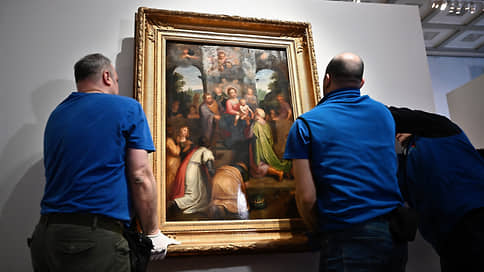The collection of the Pushkin Museum has been replenished with a painting by the Flemish artist Otto van Veen
[ad_1]

On February 19, the Pushkin State Museum of Fine Arts hosted a presentation of his recently acquired painting by the 16th-century Flemish artist Otto van Veen, “The Adoration of the Magi.” The addition is not the most impressive, but the museum considers it important. Kommersant art columnist comments Kira Dolinina.
The tradition of large museums displaying their newest acquisitions is old and venerable. In the most striking cases, the museum accumulates exhibits for a long time, so that later it can show a lot at once and with impact. Other exhibitions in this genre are based on a single gift (or purchase), most often a significant number or quality of the works presented. The latest news from the Pushkin Museum looks rather faded in this series: Otto van Veen (sometimes spelled “Octavius Venius” or “Otto Venius” is found) is a good, strong artist, a teacher of Rubens, which in itself is an important matter, but this is one of the first names of the second a number of mannerists. It seems to be not enough for a separate event. Although, let’s be honest, it’s difficult for our Western art museums to come up with truly major exhibitions and news these days. They work with what they have.
And there is the following: Otto van Veen was born in 1556 in Leiden, exactly half a century later Rembrandt would be born there. The son of a burgomaster, he received a decent education, the family was Catholic, they also taught Latin and ancient texts. In 1572, the van Weens moved to Antwerp, and then further south, to Liege. The young artist studied with Dominic Lampsonius, who once worked for the English cardinal, but his entire education was predetermined by the main event in his biography: in 1575 he went to Rome. Traveling to Italy was an absolute necessity for artists of that time: the new style that originated from there, today called international mannerism, spread at breakneck speed throughout Europe, which at that time was almost a single artistic space. But the sources had to be looked for on the Apennine Peninsula. In Rome, van Veen met the recognized star of Italian mannerism Federico Zuccaro, from whom he took the brightness, linearity, fluidity of colors and forms. His further movements – Munich, Cologne, Brussels, Antwerp, Brussels again – depended only on which of the powers that be (Emperor Rudolf II, Duke of Bavaria William V, Duke of Parma Alessandro Farnese) he fell under at one time or another.
For the history of art, the main event in the life of Otto van Veen was that in the years 1594–1600 Peter Paul Rubens studied in his workshop in Antwerp. And I must admit, he received a lot from this teacher. Van Veen died in Brussels in 1629, having seen with his own eyes the ascent of his student to the artistic Olympus.
The painting, which the Pushkin Museum bought from a private individual for an officially undisclosed sum, is an altar image quite common in van Veen’s work. This time it is “The Adoration of the Magi” (dating from about 1600, medium format), read in a completely canonical manner for its time. A multi-figured and multi-colored composition with a deep landscape behind the backs of the main characters, angels and putti as observers, with a gentle, slightly sweet Madonna and a baby Christ, too large for the scene immediately following the Nativity. Everything is in place, but everything is a bit boring. These are not at all those dashing compositions by van Veen with naked bodies from complex angles, which clearly impressed the young Rubens.
In the speeches of the museum staff at the presentation, three main messages needed to be heard: the museum continues to buy and collect; the museum has begun a re-exposition that will last all year; and “the exhibition is not a meaningless collection of masterpieces from different schools and masters, it is, first of all, a kind of summary of the history of art.” In support of the latter statement, the curator of Dutch and Flemish painting at the Pushkin Museum, Vadim Sadkov, presented what he considers a striking argument: “When this painting becomes part of the permanent exhibition of our museum, it will hang next to the paintings of Rubens, and this will be a very clear demonstration for anyone, the widest audience, the opportunity to see what Rubens took from his teachers, and what he himself, as a brilliant creative personality, brought to the history of world art.” The words are beautiful, but the novelty by van Veen, who is not the most vigorous, is unlikely to withstand this load.
It is a pity, of course, that instead the museum workers did not tell a detailed history of the origin of the painting – nothing except that for the last 30 years it has been passing through the hands of private collectors in Moscow and that for some reason in the early 1990s it was restored in the workshops of the Pushkin Museum, we did not recognize. This does not mean that its authenticity is suspect. But saying that the acquisition is serious, it’s worth starting with provenance. We’ll have to wait for the painting to be included in the catalogue.
[ad_2]
Source link






